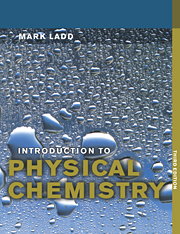Book contents
- Frontmatter
- Contents
- Preface
- Physical constants and other numerical data
- Prefixes to Units
- 1 Structure, energy, mechanism
- 2 Atoms, molecules and their structures
- 3 Determination of structure
- 4 Energy and energetics
- 5 States of matter: gases and liquids
- 6 States of matter: solids
- 7 Phase rule and properties of solutions
- 8 Chemical equilibrium
- 9 Electrochemistry
- 10 Chemical kinetics and mechanisms of chemical reactions
- Appendix 1 Problem-solving with personal computers
- Appendix 2 Stereoviewing
- Appendix 3 Average classical thermal energies
- Appendix 4 Reduced mass
- Appendix 5 Spherical polar coordinates
- Appendix 6 Gamma function
- Appendix 7 Slater's rules
- Appendix 8 Linear least squares and the propagation of errors
- Appendix 9 Determinants and cofactors
- Appendix 10 Solution of a second-order differential equation
- Appendix 11 Separation of variables
- Appendix 12 Overlap integrals
- Appendix 13 Partial derivatives
- Appendix 14 Numerical integration
- Appendix 15 Fermi-Dirac statistics
- Appendix 16 Calculation of Madelung constants
- Appendix 17 The hypsometric formula: an example of the Boltzmann distribution
- Appendix 18 Tables of physical data
- Bibliography
- Answers to numerical problems
- Index
Appendix 2 - Stereoviewing
Published online by Cambridge University Press: 05 June 2012
- Frontmatter
- Contents
- Preface
- Physical constants and other numerical data
- Prefixes to Units
- 1 Structure, energy, mechanism
- 2 Atoms, molecules and their structures
- 3 Determination of structure
- 4 Energy and energetics
- 5 States of matter: gases and liquids
- 6 States of matter: solids
- 7 Phase rule and properties of solutions
- 8 Chemical equilibrium
- 9 Electrochemistry
- 10 Chemical kinetics and mechanisms of chemical reactions
- Appendix 1 Problem-solving with personal computers
- Appendix 2 Stereoviewing
- Appendix 3 Average classical thermal energies
- Appendix 4 Reduced mass
- Appendix 5 Spherical polar coordinates
- Appendix 6 Gamma function
- Appendix 7 Slater's rules
- Appendix 8 Linear least squares and the propagation of errors
- Appendix 9 Determinants and cofactors
- Appendix 10 Solution of a second-order differential equation
- Appendix 11 Separation of variables
- Appendix 12 Overlap integrals
- Appendix 13 Partial derivatives
- Appendix 14 Numerical integration
- Appendix 15 Fermi-Dirac statistics
- Appendix 16 Calculation of Madelung constants
- Appendix 17 The hypsometric formula: an example of the Boltzmann distribution
- Appendix 18 Tables of physical data
- Bibliography
- Answers to numerical problems
- Index
Summary
The representation of molecular and crystal structures by stereoscopic pairs of drawings has become commonplace in recent years. Computer programs are available that prepare stereoviews from structural data. Two diagrams of a given object are necessary and they must correspond to the views seen by the eyes in normal vision. Correct stereoscopic viewing requires that each eye sees only the appropriate drawing, and there are several ways in which it may be accomplished.
A stereoviewer may be purchased for a modest sum. The stereoscopic drawing may be viewed directly, and the three-dimensional image appears centrally between the images of the two given drawings. Two suppliers of stereoviewers are:
(a) Casella & Co Ltd, Regent House, Britannia Walk, London N1 7ND;
(b) Taylor-Merchant, 212 West 35th Street, New York, NY10001.
The unaided eyes can be trained to defocus, so that each eye sees only the appropriate diagram. The eyes must be relaxed and look straight ahead. This process may be aided by placing a white card edgeways between the two drawings. It may be helpful to close the eyes for a moment, open them wide without attempting to focus on the diagram, and then allow them to relax. Again, the stereoview appears centrally with respect to the left and right pair of images.
- Type
- Chapter
- Information
- Introduction to Physical Chemistry , pp. 456Publisher: Cambridge University PressPrint publication year: 1998



